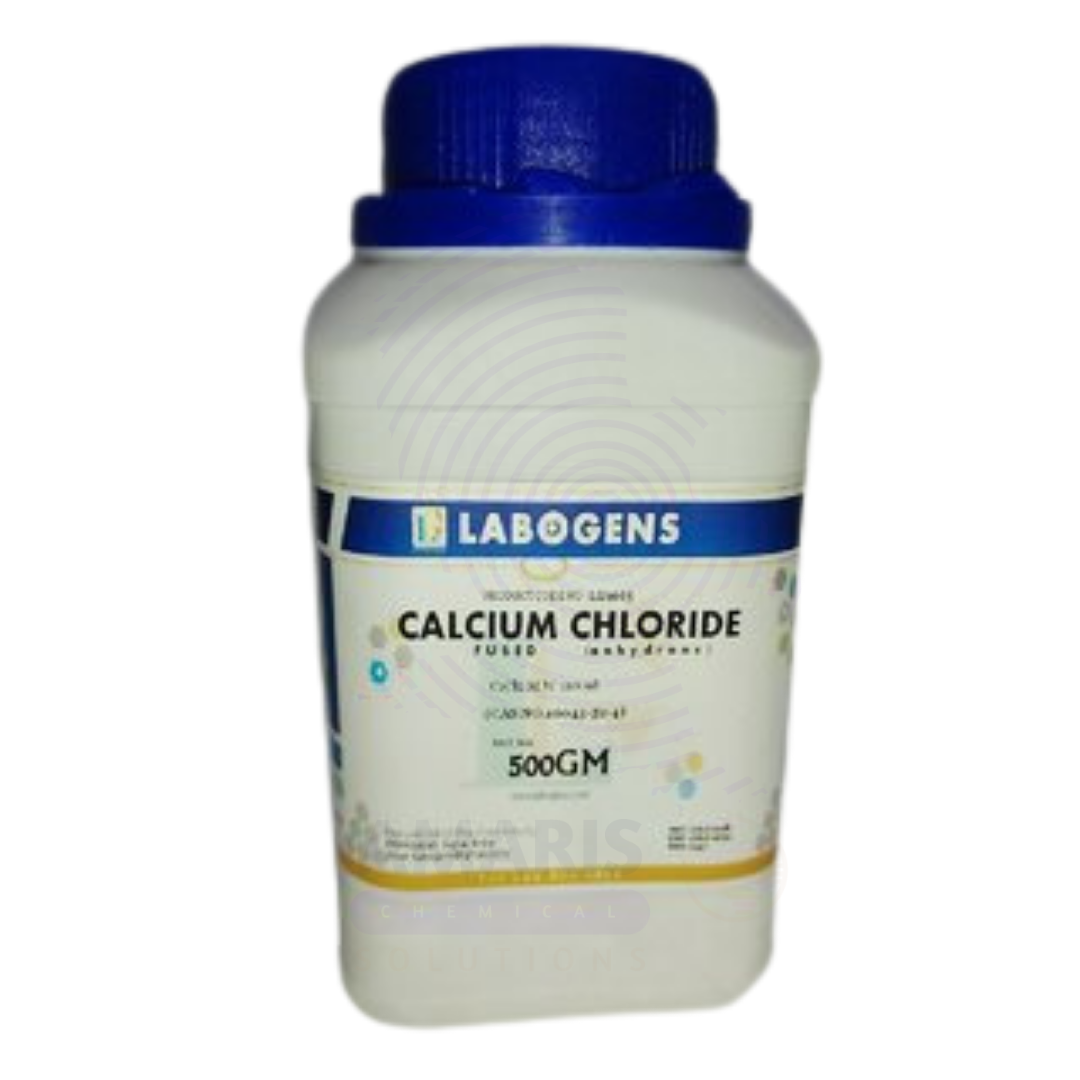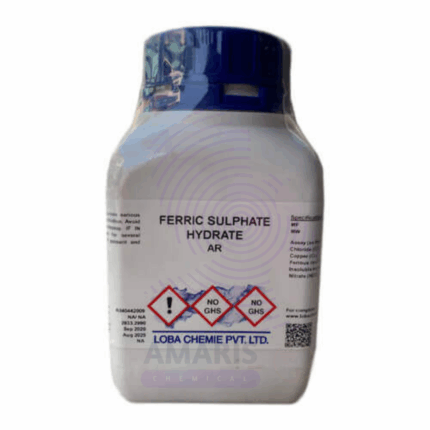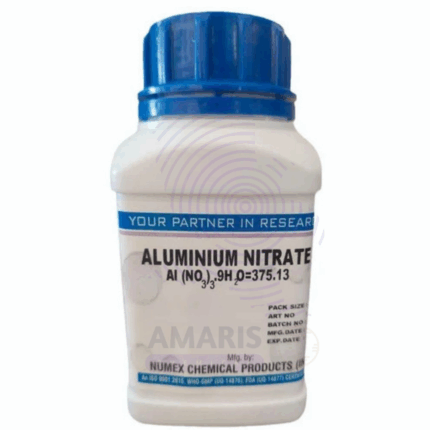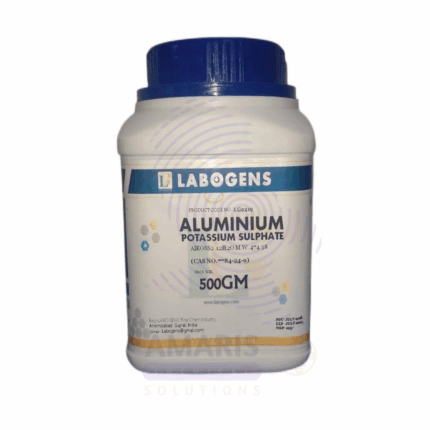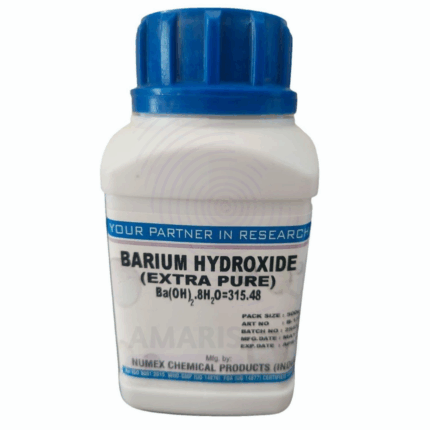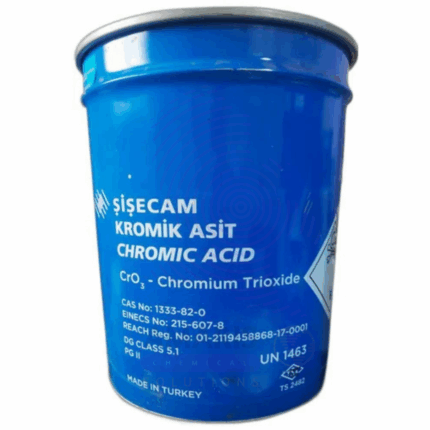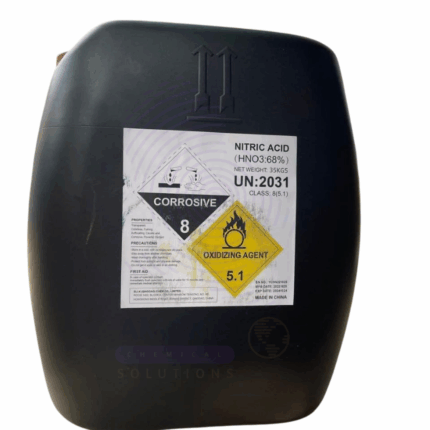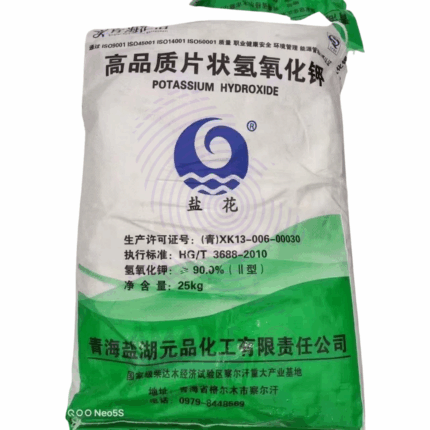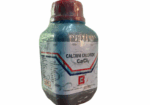
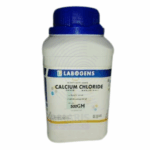
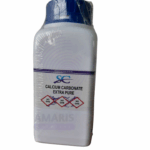

Calcium Chloride Extra Pure
$ 18.00 Original price was: $ 18.00.$ 17.87Current price is: $ 17.87.
Calcium Chloride Extra Pure is a highly pure, hygroscopic compound widely used in laboratory applications as a desiccant, electrolyte source, and reagent in analytical chemistry. It is effective in moisture control, gas drying, and as a coagulant in biological and biochemical processes. Its strong affinity for water also makes it valuable in experiments involving freezing point depression, exothermic dissolution, and ionic reactions. The extra pure grade ensures minimal impurities, which is critical for accuracy in quantitative analysis, buffer preparation, and synthesis. It should be stored in well-sealed containers in a dry environment to prevent clumping and preserve its chemical performance.
Calcium Chloride Extra Pure
Primary Uses
- Drying Agent / Desiccant
- Widely used to dry gases and organic solvents in drying tubes or desiccators due to its strong hygroscopic nature.
- Often chosen for drying non-polar solvents (e.g. ethers, hydrocarbons).
- Source of Calcium Ions in Reactions
- Supplies Ca²⁺ ions for precipitation reactions, analytical tests, or ionic exchange studies.
- Common in flame tests, where calcium imparts an orange-red flame.
- Electrolyte in Electrochemical Studies
- Acts as an ionic conductor in electrolysis and conductivity experiments, especially when calcium ions are involved.
- Osmotic and Cell Treatment Agent
- Occasionally used in molecular biology for preparing competent cells in bacterial transformation processes.
Secondary Uses
- Thermochemical Demonstrations
- Used in exothermic dissolution experiments to demonstrate enthalpy of solution and heat transfer.
- Colligative Properties Experiments
- Ideal for studying freezing point depression and boiling point elevation in solution chemistry.
- Simulation of Hard Water
- Helps recreate hard water conditions in lab studies related to water softening or soap efficiency testing.
- Standard for Moisture Absorption Tests
- Applied as a benchmark for evaluating hygroscopic properties in comparative material science studies.
| PACK SIZE |
500 grams Plastic Tin |
|---|
1. Basic Identification Attributes
- Chemical Name: Calcium Chloride (Anhydrous)
- Chemical Formula: CaCl₂
- CAS Number: 10043-52-4
- HS Code: 2827.20.00
- Grade: Extra Pure (Laboratory Grade)
- Synonyms: Calcium dichloride, CaCl₂, anhydrous calcium chloride
2. Physical & Chemical Properties
- Appearance: White or off-white granular powder or flakes
- Odor: Odorless
- Molar Mass: 110.98 g/mol
- Melting Point: 772 °C
- Boiling Point: >1600 °C (decomposes)
- Solubility:
- Highly soluble in water (exothermic)
- Soluble in alcohol, acetone
- Density: ~2.15 g/cm³
- Hygroscopic: Extremely — readily absorbs moisture from the air
- Stability: Stable under normal conditions
3. Safety & Hazard Attributes
- GHS Classification:
- Eye Irritation (Category 2A)
- Skin Irritation (Category 2)
- Hazard Statements:
- H315: Causes skin irritation
- H319: Causes serious eye irritation
- Precautionary Statements:
- Wear gloves, eye protection
- Avoid breathing dust
- NFPA Ratings:
- Health: 1
- Flammability: 0
- Reactivity: 0
4. Storage & Handling Attributes
- Storage Conditions:
- Store in tightly closed containers
- Keep in a dry, well-ventilated area
- Protect from atmospheric moisture
- Packaging: Typically supplied in HDPE or foil-sealed containers
- Handling Precautions:
- Avoid contact with skin and eyes
- Use in a fume hood if dusty
5. Regulatory & Compliance Attributes
- Transport Classification (UN): Not classified as hazardous
- Waste Disposal:
- Dispose as non-hazardous inorganic waste
- Follow institutional and local environmental regulations
6. Environmental & Health Impact
- Toxicity:
- Low acute toxicity
- Irritating to skin, eyes, and mucous membranes
- Ecotoxicity:
- Large releases may alter aquatic ionic balance
- Biodegradability: Not applicable – inorganic salt
SAFETY PRECAUTIONS
- Personal Protective Equipment (PPE):
- Wear chemical safety goggles, gloves, and lab coat.
- Use a dust mask or respirator if airborne dust is generated.
- Handling:
- Avoid breathing dust or contact with skin and eyes.
- Handle in a well-ventilated area.
- Hygroscopic: close containers immediately after use.
- Storage:
- Store in tightly sealed containers in a cool, dry place.
- Keep away from moisture and incompatible substances like strong acids, borates, and zinc.
FIRST AID MEASURES
- Inhalation:
- Move to fresh air immediately.
- Get medical attention if irritation or symptoms persist.
- Skin Contact:
- Rinse thoroughly with water.
- Remove contaminated clothing.
- Seek medical advice if irritation develops.
- Eye Contact:
- Rinse immediately with plenty of water for at least 15 minutes.
- Consult a physician if symptoms persist.
- Ingestion:
- Rinse your mouth thoroughly.
- Do not induce vomiting.
- Drink water and seek medical assistance promptly.
FIRE FIGHTING MEASURES
- Flammability:
- Non-flammable but may contribute to corrosion in fire conditions.
- Extinguishing Media:
- Use any suitable extinguishing media: water spray, CO₂, dry chemical, or foam.
- Hazardous Combustion Products:
- May release hydrogen chloride (HCl) and calcium oxide (CaO) fumes when heated.
- Special Instructions for Firefighters:
- Use SCBA (Self-Contained Breathing Apparatus) and full protective gear.


 Preservatives(food)
Preservatives(food) Flavor Enhancers
Flavor Enhancers Acidulants
Acidulants Sweeteners
Sweeteners Antioxidants
Antioxidants Colorants(food)
Colorants(food) Nutraceutical Ingredients (food)
Nutraceutical Ingredients (food) Nutrient Supplements
Nutrient Supplements Emulsifiers
Emulsifiers
 Collectors
Collectors Dust Suppressants
Dust Suppressants Explosives and Blasting Agents
Explosives and Blasting Agents Flocculants and Coagulants
Flocculants and Coagulants Frothers
Frothers Leaching Agents
Leaching Agents pH Modifiers
pH Modifiers Precious Metal Extraction Agents
Precious Metal Extraction Agents
 Antioxidants(plastic)
Antioxidants(plastic) Colorants (Pigments, Dyes)
Colorants (Pigments, Dyes) Fillers and Reinforcements
Fillers and Reinforcements Flame Retardants
Flame Retardants Monomers
Monomers Plasticizers
Plasticizers Polymerization Initiators
Polymerization Initiators Stabilizers (UV, Heat)
Stabilizers (UV, Heat)
 Antifoaming Agents
Antifoaming Agents Chelating Agents
Chelating Agents Coagulants and Flocculants
Coagulants and Flocculants Corrosion Inhibitors
Corrosion Inhibitors Disinfectants and Biocides
Disinfectants and Biocides Oxidizing Agents
Oxidizing Agents pH Adjusters
pH Adjusters Scale Inhibitors( water)
Scale Inhibitors( water)
 Antioxidants(cosmetic)
Antioxidants(cosmetic) Emollients
Emollients Fragrances and Essential Oils
Fragrances and Essential Oils Humectants
Humectants Preservatives
Preservatives Surfactants(cosmetic)
Surfactants(cosmetic) Thickeners
Thickeners UV Filters
UV Filters
 Fertilizers
Fertilizers Soil Conditioners
Soil Conditioners Plant Growth Regulators
Plant Growth Regulators Animal Feed Additives
Animal Feed Additives Biostimulants
Biostimulants Pesticides (Herbicides, Insecticides, Fungicides)
Pesticides (Herbicides, Insecticides, Fungicides)
 Active Pharmaceutical Ingredients (APIs)
Active Pharmaceutical Ingredients (APIs) Excipients
Excipients Solvents(pharmaceutical)
Solvents(pharmaceutical) Antibiotics
Antibiotics Antiseptics and Disinfectants
Antiseptics and Disinfectants Vaccine Adjuvants
Vaccine Adjuvants Nutraceutical Ingredients (pharmaceutical)
Nutraceutical Ingredients (pharmaceutical) Analgesics & Antipyretics
Analgesics & Antipyretics
 Analytical Reagents
Analytical Reagents Solvents(lab)
Solvents(lab) Chromatography Chemicals
Chromatography Chemicals Spectroscopy Reagents
Spectroscopy Reagents microbiology-and-cell-culture-reagents
microbiology-and-cell-culture-reagents Molecular Biology Reagents
Molecular Biology Reagents Biochemical Reagents
Biochemical Reagents Inorganic and Organic Standards
Inorganic and Organic Standards Laboratory Safety Chemicals
Laboratory Safety Chemicals Specialty Laboratory Chemicals(Special Laboratory Equipment)
Specialty Laboratory Chemicals(Special Laboratory Equipment)
 Demulsifiers
Demulsifiers Hydraulic Fracturing Fluids
Hydraulic Fracturing Fluids Scale Inhibitors(oil)
Scale Inhibitors(oil) Surfactants(oil)
Surfactants(oil) Drilling Fluids
Drilling Fluids
 Dyes and Pigments
Dyes and Pigments Bleaching Agents
Bleaching Agents Softening Agents
Softening Agents Finishing Agents
Finishing Agents Antistatic Agents
Antistatic Agents
 Admixtures
Admixtures Waterproofing Agents
Waterproofing Agents Sealants and Adhesives
Sealants and Adhesives Curing Compounds
Curing Compounds Concrete Repair Chemicals
Concrete Repair Chemicals Anti-Corrosion Coatings
Anti-Corrosion Coatings
 Surfactants(cleaning)
Surfactants(cleaning) Builders
Builders Enzymes
Enzymes Solvents (Cleaning)
Solvents (Cleaning) Fragrances
Fragrances
 Electronic Chemicals
Electronic Chemicals Catalysts
Catalysts Lubricants
Lubricants Photographic Chemicals
Photographic Chemicals Refrigerants
Refrigerants Automotive chemicals
Automotive chemicals Pyrotechnic Chemicals
Pyrotechnic Chemicals
 Biodegradable Surfactants
Biodegradable Surfactants Bio-based Solvents
Bio-based Solvents Renewable Polymers
Renewable Polymers Carbon Capture Chemicals
Carbon Capture Chemicals Wastewater Treatment Chemicals
Wastewater Treatment Chemicals
 Pigments
Pigments Solvents(paint)
Solvents(paint) Specialty Coatings
Specialty Coatings Binders/Resins
Binders/Resins Additives
Additives Driers
Driers Anti-Corrosion Agents
Anti-Corrosion Agents Functional Coatings
Functional Coatings Application-Specific Coatings
Application-Specific Coatings
 Fresh Herbs
Fresh Herbs Ground Spices
Ground Spices Whole Spices
Whole Spices Spice Blends
Spice Blends Dried Herbs
Dried Herbs
 Leavening Agents
Leavening Agents Dough Conditioners
Dough Conditioners Flour Treatments
Flour Treatments Fat Replacers
Fat Replacers Decoratives
Decoratives Preservatives(baking)
Preservatives(baking)
 Plasticizers & Softeners
Plasticizers & Softeners Reinforcing Agents
Reinforcing Agents Adhesion Promoters
Adhesion Promoters Vulcanizing Agents
Vulcanizing Agents Antidegradants
Antidegradants Blowing Agents
Blowing Agents Fillers & Extenders
Fillers & Extenders Accelerators & Retarders
Accelerators & Retarders
